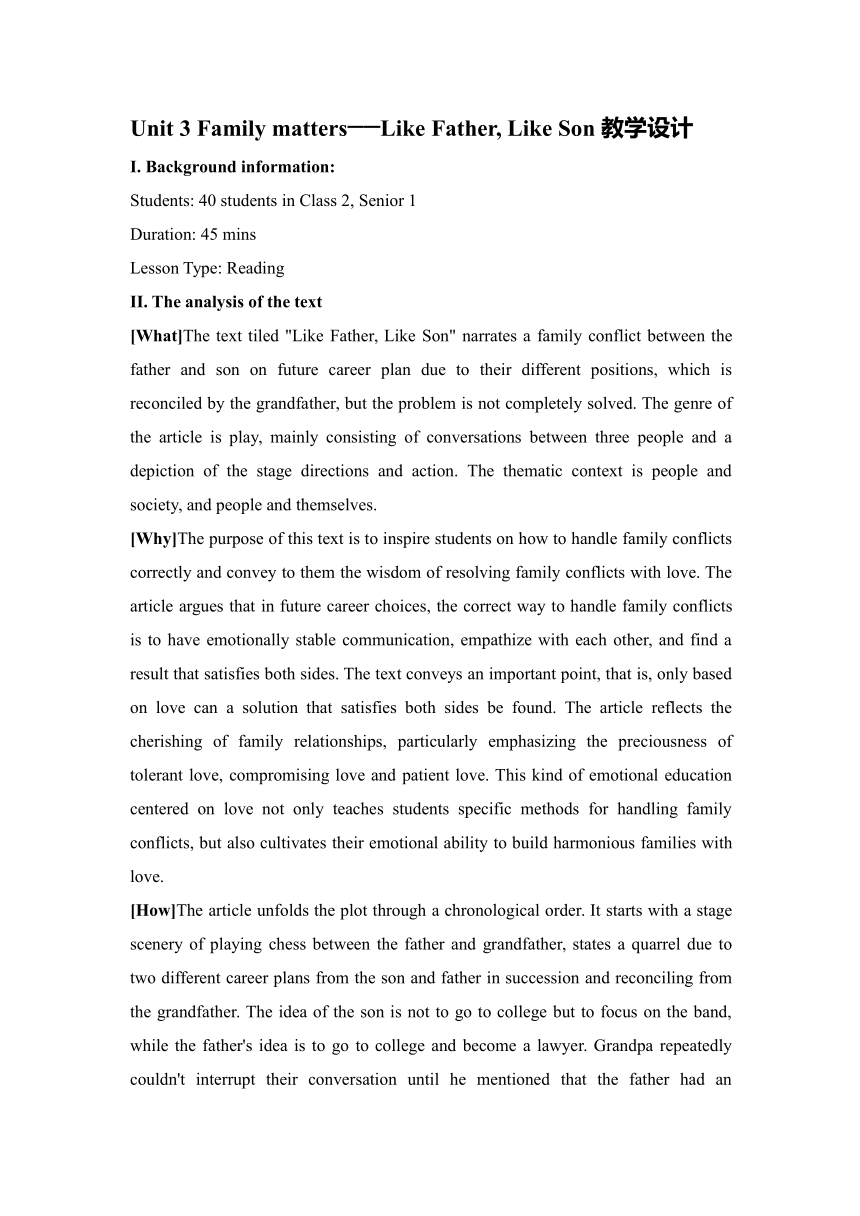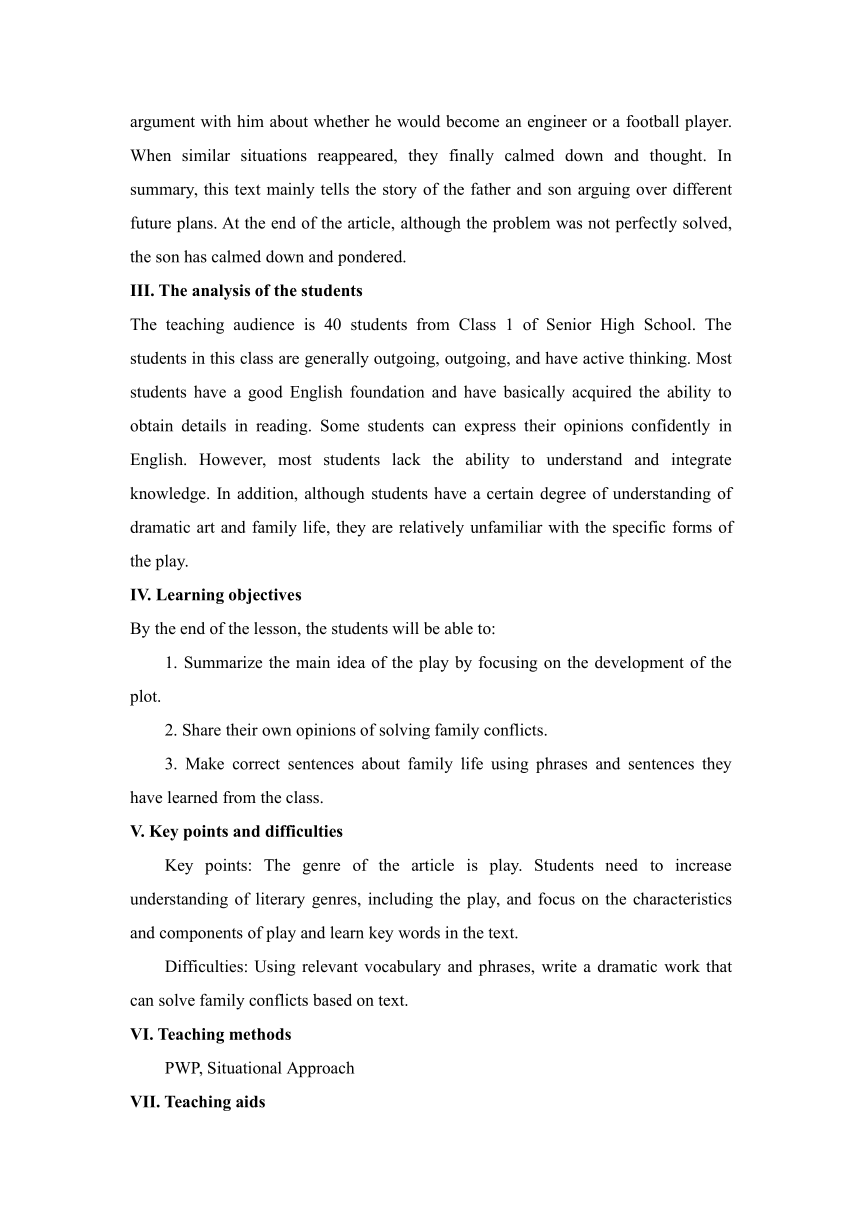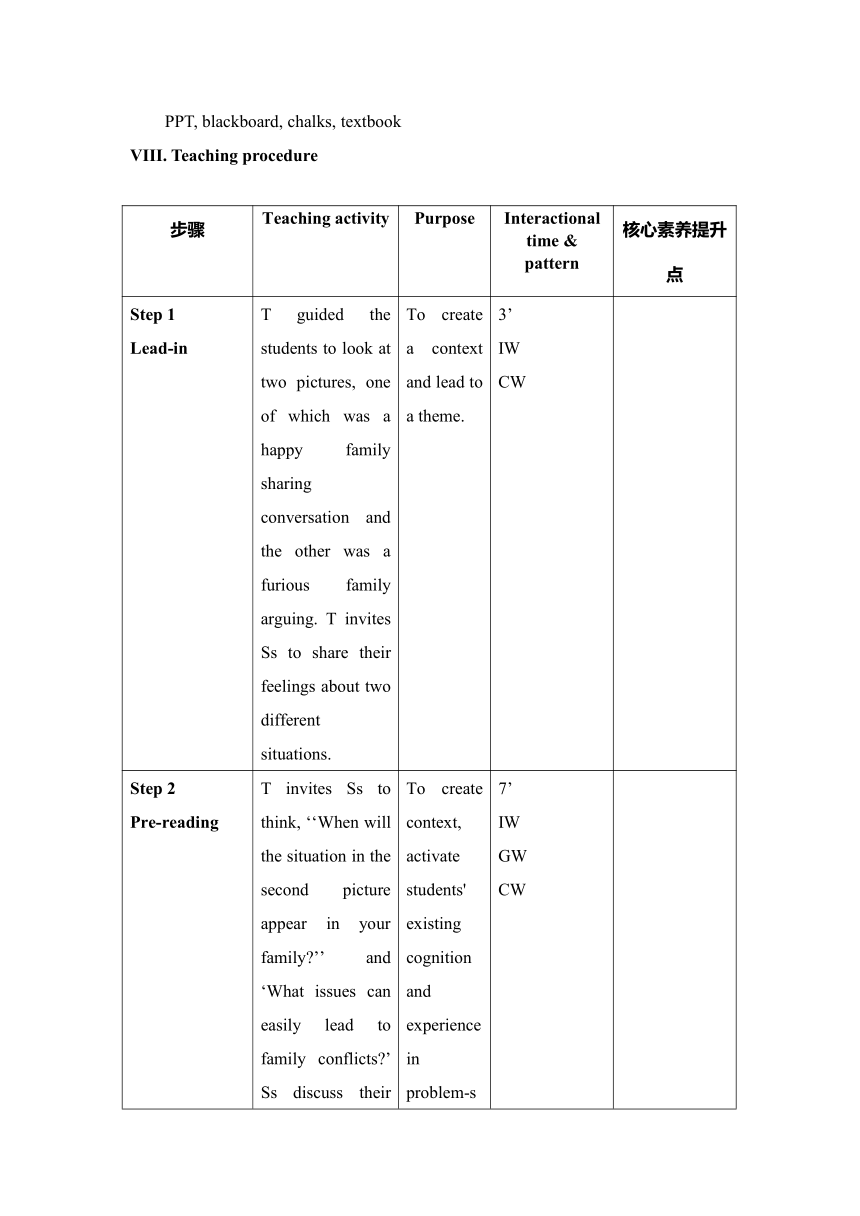Unit3 Family matters Understanding ideas Like father,like son阅读课教学设计(表格式)-2025-2026学年高中英语外研版必修第一册
文档属性
| 名称 | Unit3 Family matters Understanding ideas Like father,like son阅读课教学设计(表格式)-2025-2026学年高中英语外研版必修第一册 |  | |
| 格式 | docx | ||
| 文件大小 | 490.7KB | ||
| 资源类型 | 教案 | ||
| 版本资源 | 外研版(2019) | ||
| 科目 | 英语 | ||
| 更新时间 | 2025-08-02 17:14:13 | ||
图片预览



文档简介
Unit 3 Family matters──Like Father, Like Son教学设计
I. Background information:
Students: 40 students in Class 2, Senior 1
Duration: 45 mins
Lesson Type: Reading
II. The analysis of the text
[What]The text tiled "Like Father, Like Son" narrates a family conflict between the father and son on future career plan due to their different positions, which is reconciled by the grandfather, but the problem is not completely solved. The genre of the article is play, mainly consisting of conversations between three people and a depiction of the stage directions and action. The thematic context is people and society, and people and themselves.
[Why]The purpose of this text is to inspire students on how to handle family conflicts correctly and convey to them the wisdom of resolving family conflicts with love. The article argues that in future career choices, the correct way to handle family conflicts is to have emotionally stable communication, empathize with each other, and find a result that satisfies both sides. The text conveys an important point, that is, only based on love can a solution that satisfies both sides be found. The article reflects the cherishing of family relationships, particularly emphasizing the preciousness of tolerant love, compromising love and patient love. This kind of emotional education centered on love not only teaches students specific methods for handling family conflicts, but also cultivates their emotional ability to build harmonious families with love.
[How]The article unfolds the plot through a chronological order. It starts with a stage scenery of playing chess between the father and grandfather, states a quarrel due to two different career plans from the son and father in succession and reconciling from the grandfather. The idea of the son is not to go to college but to focus on the band, while the father's idea is to go to college and become a lawyer. Grandpa repeatedly couldn't interrupt their conversation until he mentioned that the father had an argument with him about whether he would become an engineer or a football player. When similar situations reappeared, they finally calmed down and thought. In summary, this text mainly tells the story of the father and son arguing over different future plans. At the end of the article, although the problem was not perfectly solved, the son has calmed down and pondered.
III. The analysis of the students
The teaching audience is 40 students from Class 1 of Senior High School. The students in this class are generally outgoing, outgoing, and have active thinking. Most students have a good English foundation and have basically acquired the ability to obtain details in reading. Some students can express their opinions confidently in English. However, most students lack the ability to understand and integrate knowledge. In addition, although students have a certain degree of understanding of dramatic art and family life, they are relatively unfamiliar with the specific forms of the play.
IV. Learning objectives
By the end of the lesson, the students will be able to:
1. Summarize the main idea of the play by focusing on the development of the plot.
2. Share their own opinions of solving family conflicts.
3. Make correct sentences about family life using phrases and sentences they have learned from the class.
V. Key points and difficulties
Key points: The genre of the article is play. Students need to increase understanding of literary genres, including the play, and focus on the characteristics and components of play and learn key words in the text.
Difficulties: Using relevant vocabulary and phrases, write a dramatic work that can solve family conflicts based on text.
VI. Teaching methods
PWP, Situational Approach
VII. Teaching aids
PPT, blackboard, chalks, textbook
VIII. Teaching procedure
步骤 Teaching activity Purpose Interactional time & pattern 核心素养提升点
Step 1 Lead-in T guided the students to look at two pictures, one of which was a happy family sharing conversation and the other was a furious family arguing. T invites Ss to share their feelings about two different situations. To create a context and lead to a theme. 3’ IW CW
Step 2 Pre-reading T invites Ss to think, ‘‘When will the situation in the second picture appear in your family ’’ and ‘What issues can easily lead to family conflicts ’ Ss discuss their opinions in groups and share their ideas with the whole class. To create context, activate students' existing cognition and experience in problem-solving, and elicit students' questions to form reading expectations. 7’ IW GW CW
Step 3 While-reading Ss browse the text and then work in groups to illustrate the flow charts of the article. (GW) To sort and summarize text information. 20’ IW GW CW 语言能力:获取、概括信息。
Ss describe the flow charts and share it to the whole class. T invites Ss to think “If you were in a similar situation to the son, what would you do ’’ Ss share their methods on the blackboard and continuously supplement. 语言能力:提出自己的问题。 思维品质:概括、整合信息。 学习能力:自主学习、合作学习。
Step 4 Post-reading Ss summarize the personality traits of grandpa, father, and son. T invites Ss to share them. To cultivate students' ability to apply knowledge. 8’ IW GW 语言能力:整合运用语言进行表达。
Step 5 Homework Students continue to write an ending by imitating the original text. To deepen students' mastery of knowledge points. 2’ 学习能力:梳理学习内容。
IX. Blackboard design
X. Reflection
Strengths:
Group activities in the classroom can stimulate students' enthusiasm and cultivate their thinking and expression abilities.
Being able to use modern teaching methods such as multimedia teaching and courseware production to bring vitality to classroom teaching.
The course structure is clear and all links are well connected.
Weaknesses:
The efficiency of group cooperation is not high enough.
The classroom language used by teachers is not scientific and standardized enough, and the practice design is not hierarchical and targeted enough.
The classroom content is not rich enough, and students can practice more intensively.
Appendix: Teaching materials
I. Background information:
Students: 40 students in Class 2, Senior 1
Duration: 45 mins
Lesson Type: Reading
II. The analysis of the text
[What]The text tiled "Like Father, Like Son" narrates a family conflict between the father and son on future career plan due to their different positions, which is reconciled by the grandfather, but the problem is not completely solved. The genre of the article is play, mainly consisting of conversations between three people and a depiction of the stage directions and action. The thematic context is people and society, and people and themselves.
[Why]The purpose of this text is to inspire students on how to handle family conflicts correctly and convey to them the wisdom of resolving family conflicts with love. The article argues that in future career choices, the correct way to handle family conflicts is to have emotionally stable communication, empathize with each other, and find a result that satisfies both sides. The text conveys an important point, that is, only based on love can a solution that satisfies both sides be found. The article reflects the cherishing of family relationships, particularly emphasizing the preciousness of tolerant love, compromising love and patient love. This kind of emotional education centered on love not only teaches students specific methods for handling family conflicts, but also cultivates their emotional ability to build harmonious families with love.
[How]The article unfolds the plot through a chronological order. It starts with a stage scenery of playing chess between the father and grandfather, states a quarrel due to two different career plans from the son and father in succession and reconciling from the grandfather. The idea of the son is not to go to college but to focus on the band, while the father's idea is to go to college and become a lawyer. Grandpa repeatedly couldn't interrupt their conversation until he mentioned that the father had an argument with him about whether he would become an engineer or a football player. When similar situations reappeared, they finally calmed down and thought. In summary, this text mainly tells the story of the father and son arguing over different future plans. At the end of the article, although the problem was not perfectly solved, the son has calmed down and pondered.
III. The analysis of the students
The teaching audience is 40 students from Class 1 of Senior High School. The students in this class are generally outgoing, outgoing, and have active thinking. Most students have a good English foundation and have basically acquired the ability to obtain details in reading. Some students can express their opinions confidently in English. However, most students lack the ability to understand and integrate knowledge. In addition, although students have a certain degree of understanding of dramatic art and family life, they are relatively unfamiliar with the specific forms of the play.
IV. Learning objectives
By the end of the lesson, the students will be able to:
1. Summarize the main idea of the play by focusing on the development of the plot.
2. Share their own opinions of solving family conflicts.
3. Make correct sentences about family life using phrases and sentences they have learned from the class.
V. Key points and difficulties
Key points: The genre of the article is play. Students need to increase understanding of literary genres, including the play, and focus on the characteristics and components of play and learn key words in the text.
Difficulties: Using relevant vocabulary and phrases, write a dramatic work that can solve family conflicts based on text.
VI. Teaching methods
PWP, Situational Approach
VII. Teaching aids
PPT, blackboard, chalks, textbook
VIII. Teaching procedure
步骤 Teaching activity Purpose Interactional time & pattern 核心素养提升点
Step 1 Lead-in T guided the students to look at two pictures, one of which was a happy family sharing conversation and the other was a furious family arguing. T invites Ss to share their feelings about two different situations. To create a context and lead to a theme. 3’ IW CW
Step 2 Pre-reading T invites Ss to think, ‘‘When will the situation in the second picture appear in your family ’’ and ‘What issues can easily lead to family conflicts ’ Ss discuss their opinions in groups and share their ideas with the whole class. To create context, activate students' existing cognition and experience in problem-solving, and elicit students' questions to form reading expectations. 7’ IW GW CW
Step 3 While-reading Ss browse the text and then work in groups to illustrate the flow charts of the article. (GW) To sort and summarize text information. 20’ IW GW CW 语言能力:获取、概括信息。
Ss describe the flow charts and share it to the whole class. T invites Ss to think “If you were in a similar situation to the son, what would you do ’’ Ss share their methods on the blackboard and continuously supplement. 语言能力:提出自己的问题。 思维品质:概括、整合信息。 学习能力:自主学习、合作学习。
Step 4 Post-reading Ss summarize the personality traits of grandpa, father, and son. T invites Ss to share them. To cultivate students' ability to apply knowledge. 8’ IW GW 语言能力:整合运用语言进行表达。
Step 5 Homework Students continue to write an ending by imitating the original text. To deepen students' mastery of knowledge points. 2’ 学习能力:梳理学习内容。
IX. Blackboard design
X. Reflection
Strengths:
Group activities in the classroom can stimulate students' enthusiasm and cultivate their thinking and expression abilities.
Being able to use modern teaching methods such as multimedia teaching and courseware production to bring vitality to classroom teaching.
The course structure is clear and all links are well connected.
Weaknesses:
The efficiency of group cooperation is not high enough.
The classroom language used by teachers is not scientific and standardized enough, and the practice design is not hierarchical and targeted enough.
The classroom content is not rich enough, and students can practice more intensively.
Appendix: Teaching materials
